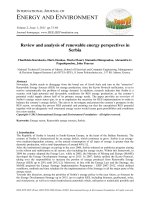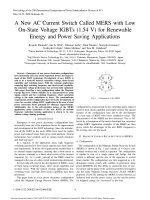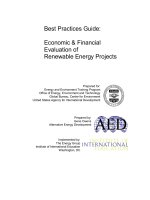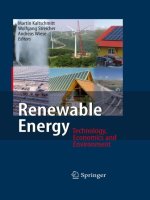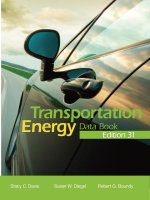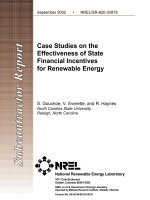renewable energy resources (book)
Bạn đang xem bản rút gọn của tài liệu. Xem và tải ngay bản đầy đủ của tài liệu tại đây (10.51 MB, 625 trang )
Renewable Energy Resources
Renewable Energy Resources is a numerate and quantitative text covering subjects
of proven technical and economic importance worldwide. Energy supplies from
renewables (such as solar, thermal, photovoltaic, wind, hydro, biofuels, wave, tidal,
ocean and geothermal sources) are essential components of every nation’s energy
strategy, not least because of concerns for the environment and for sustainability.
In the years between the first and this second edition, renewable energy has come
of age: it makes good sense, good government and good business.
This second edition maintains the book’s basis on fundamentals, whilst including experience gained from the rapid growth of renewable energy technologies as
secure national resources and for climate change mitigation, more extensively illustrated with case studies and worked problems. The presentation has been improved
throughout, along with a new chapter on economics and institutional factors. Each
chapter begins with fundamental theory from a scientific perspective, then considers
applied engineering examples and developments, and includes a set of problems and
solutions and a bibliography of printed and web-based material for further study.
Common symbols and cross referencing apply throughout, essential data are tabulated in appendices. Sections on social and environmental aspects have been added
to each technology chapter.
Renewable Energy Resources supports multi-disciplinary master degrees in science and engineering, and specialist modules in first degrees. Practising scientists
and engineers who have not had a comprehensive training in renewable energy will
find this book a useful introductory text and a reference book.
John Twidell has considerable experience in renewable energy as an academic professor, a board member of wind and solar professional associations, a journal editor
and contractor with the European Commission. As well as holding posts in the UK,
he has worked in Sudan and Fiji.
Tony Weir is a policy adviser to the Australian government, specialising in the
interface between technology and policy, covering subjects such as energy supply
and demand, climate change and innovation in business. He was formerly Senior
Energy Officer at the South Pacific Forum Secretariat in Fiji, and has lectured and
researched in physics and policy studies at universities of the UK, Australia and the
Pacific.
Also available from Taylor & Francis
∗∗
Evaluation of the Built Environment for
Sustainability∗∗
V. Bentivegna, P.S. Brandon and P. Lombardi
Hb: 0-419-21990-0
Spon Press
∗∗
Geothermal Energy for Developing Countries∗∗
D. Chandrasekharam and J. Bundschuh
Hb: 9058095223
Spon Press
∗∗
Building Energy Management Systems, 2nd ed∗∗
G. Levermore
Hb: 0-419-26140-0
Pb: 0-419-22590-0
Spon Press
∗∗
Cutting the Cost of Cold: Affordable Warmth
for Healthier Homes∗∗
F. Nicol and J. Rudge
Pb: 0-419-25050-6
Spon Press
Information and ordering details
For price availability and ordering visit our website www.sponpress.com
Alternatively our books are available from all good bookshops.
Renewable Energy
Resources
Second edition
John Twidell and Tony Weir
First published 1986
by E&FN Spon Ltd
Second edition published 2006
by Taylor & Francis
2 Park Square, Milton Park, Abingdon, Oxon OX14 4RN
Simultaneously published in the USA and Canada
by Taylor & Francis
270 Madison Ave, New York, NY 10016, USA
This edition published in the Taylor & Francis e-Library, 2006.
“To purchase your own copy of this or any of Taylor & Francis or Routledge’s
collection of thousands of eBooks please go to www.eBookstore.tandf.co.uk.”
Taylor & Francis is an imprint of the Taylor & Francis Group
© 1986, 2006 John W. Twidell and Anthony D. Weir
All rights reserved. No part of this book may be reprinted or
reproduced or utilised in any form or by any electronic, mechanical, or
other means, now known or hereafter invented, including photocopying
and recording, or in any information storage or retrieval system, without
permission in writing from the publishers.
The publisher makes no representation, express or implied, with regard
to the accuracy of the information contained in this book and cannot
accept any legal responsibility or liability for any errors or
omissions that may be made.
British Library Cataloguing in Publication Data
A catalogue record for this book is available
from the British Library
Library of Congress Cataloging in Publication Data
Twidell, John.
Renewable energy resources / John Twidell and
Anthony Weir. — 2nd ed.
p. cm.
Includes bibliographical references and index.
ISBN 0–419–25320–3 (hardback) — ISBN 0–419–25330–0 (pbk.)
1. Renewable energy sources. I. Weir, Anthony D. II. Title.
TJ808.T95 2005
621.042—dc22
2005015300
ISBN10: 0–419–25320–3
ISBN10: 0–419–25330–0
ISBN13: 9–78–0–419–25320–4 Hardback
ISBN13: 9–78–0–419–25330–3 Paperback
Contents
Preface
List of symbols
1 Principles of renewable energy
1.1
1.2
1.3
1.4
1.5
1.6
1
Introduction 1
Energy and sustainable development 2
Fundamentals 7
Scientific principles of renewable energy 12
Technical implications 16
Social implications 22
Problems 24
Bibliography 25
2 Essentials of fluid dynamics
2.1
2.2
2.3
2.4
2.5
2.6
2.7
xi
xvii
29
Introduction 29
Conservation of energy: Bernoulli’s equation 30
Conservation of momentum 32
Viscosity 33
Turbulence 34
Friction in pipe flow 35
Lift and drag forces: fluid and turbine machinery 39
Problems 41
Bibliography 44
3 Heat transfer
3.1 Introduction 45
3.2 Heat circuit analysis and terminology 46
3.3 Conduction 49
45
vi Contents
3.4
3.5
3.6
3.7
3.8
Convection 51
Radiative heat transfer 61
Properties of ‘transparent’ materials 73
Heat transfer by mass transport 74
Multimode transfer and circuit analysis 77
Problems 80
Bibliography 82
4 Solar radiation
4.1
4.2
4.3
4.4
4.5
4.6
4.7
4.8
Introduction 85
Extraterrestrial solar radiation 86
Components of radiation 87
Geometry of the Earth and Sun 89
Geometry of collector and the solar beam 93
Effects of the Earth’s atmosphere 98
Measurements of solar radiation 104
Estimation of solar radiation 107
Problems 110
Bibliography 112
5 Solar water heating
5.1
5.2
5.3
5.4
5.5
5.6
5.7
5.8
115
Introduction 115
Calculation of heat balance: general remarks 118
Uncovered solar water heaters – progressive analysis 119
Improved solar water heaters 123
Systems with separate storage 129
Selective surfaces 134
Evacuated collectors 137
Social and environmental aspects 140
Problems 141
Bibliography 145
6 Buildings and other solar thermal applications
6.1
6.2
6.3
6.4
6.5
6.6
85
Introduction 146
Air heaters 147
Energy-efficient buildings 149
Crop driers 157
Space cooling 161
Water desalination 162
146
Contents vii
6.7
6.8
6.9
6.10
Solar ponds 164
Solar concentrators 166
Solar thermal electric power systems 170
Social and environmental aspects 173
Problems 175
Bibliography 179
7 Photovoltaic generation
7.1
7.2
7.3
7.4
7.5
7.6
7.7
7.8
7.9
7.10
Introduction 182
The silicon p–n junction 184
Photon absorption at the junction 193
Solar radiation absorption 197
Maximising cell efficiency 200
Solar cell construction 208
Types and adaptations of photovoltaics 210
Photovoltaic circuit properties 220
Applications and systems 224
Social and environmental aspects 229
Problems 233
Bibliography 234
8 Hydro-power
8.1
8.2
8.3
8.4
8.5
8.6
8.7
8.8
237
Introduction 237
Principles 240
Assessing the resource for small installations 240
An impulse turbine 244
Reaction turbines 249
Hydroelectric systems 252
The hydraulic ram pump 255
Social and environmental aspects 257
Problems 258
Bibliography 261
9 Power from the wind
9.1
9.2
9.3
9.4
9.5
182
Introduction 263
Turbine types and terms 268
Linear momentum and basic theory 273
Dynamic matching 283
Blade element theory 288
263
viii
Contents
9.6
9.7
9.8
9.9
9.10
Characteristics of the wind 290
Power extraction by a turbine 305
Electricity generation 307
Mechanical power 316
Social and environmental considerations 318
Problems 319
Bibliography 322
10 The photosynthetic process
10.1
10.2
10.3
10.4
10.5
10.6
10.7
Introduction 324
Trophic level photosynthesis 326
Photosynthesis at the plant level 330
Thermodynamic considerations 336
Photophysics 338
Molecular level photosynthesis 343
Applied photosynthesis 348
Problems 349
Bibliography 350
11 Biomass and biofuels
11.1
11.2
11.3
11.4
11.5
11.6
11.7
11.8
11.9
11.10
11.11
351
Introduction 351
Biofuel classification 354
Biomass production for energy farming 357
Direct combustion for heat 365
Pyrolysis (destructive distillation) 370
Further thermochemical processes 374
Alcoholic fermentation 375
Anaerobic digestion for biogas 379
Wastes and residues 387
Vegetable oils and biodiesel 388
Social and environmental aspects 389
Problems 395
Bibliography 397
12 Wave power
12.1
12.2
12.3
12.4
12.5
324
Introduction 400
Wave motion 402
Wave energy and power 406
Wave patterns 412
Devices 418
400
Contents ix
12.6 Social and environmental aspects 422
Problems 424
Bibliography 427
13 Tidal power
13.1
13.2
13.3
13.4
13.5
13.6
13.7
Introduction 429
The cause of tides 431
Enhancement of tides 438
Tidal current/stream power 442
Tidal range power 443
World range power sites 447
Social and environmental aspects of tidal range power 449
Problems 450
Bibliography 451
14 Ocean thermal energy conversion (OTEC)
14.1
14.2
14.3
14.4
14.5
14.6
471
Introduction 471
Geophysics 472
Dry rock and hot aquifer analysis 475
Harnessing Geothermal Resources 481
Social and environmental aspects 483
Problems 487
Bibliography 487
16 Energy systems, storage and transmission
16.1
16.2
16.3
16.4
16.5
16.6
453
Introduction 453
Principles 454
Heat exchangers 458
Pumping requirements 464
Other practical considerations 465
Environmental impact 468
Problems 469
Bibliography 469
15 Geothermal energy
15.1
15.2
15.3
15.4
15.5
429
The importance of energy storage and distribution 489
Biological storage 490
Chemical storage 490
Heat storage 495
Electrical storage: batteries and accumulators 499
Fuel cells 506
489
x Contents
16.7
16.8
16.9
16.10
Mechanical storage 507
Distribution of energy 509
Electrical power 513
Social and environmental aspects 520
Problems 521
Bibliography 524
17 Institutional and economic factors
17.1
17.2
17.3
17.4
17.5
17.6
526
Introduction 526
Socio-political factors 526
Economics 530
Some policy tools 534
Quantifying choice 536
The way ahead 545
Problems 550
Bibliography 550
Appendix A Units and conversions
Appendix B Data
Appendix C Some heat transfer formulas
Solution guide to problems
Index
553
558
564
568
581
Preface
Our aim
Renewable Energy Resources is a numerate and quantitative text covering
subjects of proven technical and economic importance worldwide. Energy
supply from renewables is an essential component of every nation’s strategy, especially when there is responsibility for the environment and for
sustainability.
This book considers the timeless principles of renewable energy technologies, yet seeks to demonstrate modern application and case studies.
Renewable Energy Resources supports multi-disciplinary master degrees in
science and engineering, and also specialist modules in science and engineering first degrees. Moreover, since many practising scientists and engineers
will not have had a general training in renewable energy, the book has wider
use beyond colleges and universities. Each chapter begins with fundamental
theory from a physical science perspective, then considers applied examples and developments, and finally concludes with a set of problems and
solutions. The whole book is structured to share common material and to
relate aspects together. After each chapter, reading and web-based material
is indicated for further study. Therefore the book is intended both for basic
study and for application. Throughout the book and in the appendices, we
include essential and useful reference material.
The subject
Renewable energy supplies are of ever increasing environmental and economic importance in all countries. A wide range of renewable energy technologies are established commercially and recognised as growth industries
by most governments. World agencies, such as the United Nations, have
large programmes to encourage the technology. In this book we stress the
scientific understanding and analysis of renewable energy, since we believe
these are distinctive and require specialist attention. The subject is not easy,
mainly because of the spread of disciplines involved, which is why we aim
to unify the approach within one book.
xii Preface
This book bridges the gap between descriptive reviews and specialised
engineering treatises on particular aspects. It centres on demonstrating how
fundamental physical processes govern renewable energy resources and their
application. Although the applications are being updated continually, the
fundamental principles remain the same and we are confident that this new
edition will continue to provide a useful platform for those advancing the
subject and its industries. We have been encouraged in this approach by the
ever increasing commercial importance of renewable energy technologies.
Why a second edition?
In the relatively few years between the first edition, with five reprinted
revisions, and this second edition, renewable energy has come of age; its
use makes good sense, good government and good business. From being
(apart from hydro-power) small-scale ‘curiosities’ promoted by idealists,
renewables have become mainstream technologies, produced and operated
by companies competing in an increasingly open market where consumers
and politicians are very conscious of sustainability issues.
In recognition of the social, political and institutional factors which continue to drive this change, this new edition includes a new final chapter
on institutional and economic factors. The new chapter also discusses and
demonstrates some tools for evaluating the increasingly favourable economics of renewable energy systems. There is also a substantial new section
in Chapter 1 showing how renewable energy is a key component of sustainable development, an ideal which has become much more explicit since
the first edition. Each technology chapter now includes a brief concluding
section on its social and environmental impacts.
The book maintains the same general format as the first edition, but
many improvements and updates have been made. In particular we wish
to relate to the vibrant developments in the individual renewable energy
technologies, and to the related commercial growth. We have improved the
presentation of the fundamentals throughout, in the light of our teaching
experience. Although the book continues to focus on fundamental physical principles, which have not changed, we have updated the technological
applications and their relative emphases to reflect market experience. For
electricity generation, wind-power and photovoltaics have had dramatic
growth over the last two decades, both in terms of installed capacity and
in sophistication of the industries. In all aspects of renewable energy, composite materials and microelectronic control have transformed traditional
technologies, including hydro-power and the use of biomass.
Extra problems have been added at the end of each chapter, with hints
and guidance for all solutions as an appendix. We continue to emphasise
simplified, order-of-magnitude, calculations of the potential outputs of the
various technologies. Such calculations are especially useful in indicating
Preface
xiii
the potential applicability of a technology for a particular site. However we
appreciate that specialists increasingly use computer modelling of whole,
complex systems; in our view such modelling is essential but only after
initial calculation as presented here.
Readership
We expect our readers to have a basic understanding of science and technology, especially of physical science and mathematics. It is not necessary
to read or refer to chapters consecutively, as each aspect of the subject is
treated, in the main, as independent of the other aspects. However, some
common elements, especially heat transfer, will have to be studied seriously
if the reader is to progress to any depth of understanding in solar energy.
The disciplines behind a proper understanding and application of renewable energy also include environmental science, chemistry and engineering,
with social science vital for dissemination. We are aware that readers with
a physical science background will usually be unfamiliar with life science
and agricultural science, but we stress the importance of these subjects with
obvious application for biofuels and for developments akin to photosynthesis. We ourselves see renewable energy as within human-inclusive ecology,
both now and for a sustainable future.
Ourselves
We would like our readers to enjoy the subject of renewable energy, as
we do, and to be stimulated to apply the energy sources for the benefit
of their societies. Our own interest and commitment has evolved from the
work in both hemispheres and in a range of countries. We first taught,
and therefore learnt, renewable energy at the University of Strathclyde in
Glasgow (JWT) and the University of the South Pacific in Fiji (ADW and
JWT). So teaching, together with research and application in Scotland and
the South Pacific, has been a strong influence for this book. Since the first
edition we have made separate careers in universities and in government
service, whilst experiencing the remarkable, but predicable, growth in relevance of renewable energy. One of us (JWT) became Director of the Energy
Studies Unit, in the Faculty of Engineering at the University of Strathclyde
in Glasgow, Scotland, and then accepted the Chair in Renewable Energy
at the AMSET Centre, De Montfort University, Leicester, England. He is
editor of the academic journal Wind Engineering, has been a Council and
Board member of the British Wind Energy Association and the UK Solar
Energy Society, and has supervised many postgraduates for their dissertations. The AMSET Centre is now a private company, for research, education
and training in renewables; support is given to MSc courses at Reading
University, Oxford University and City University, and there are European
xiv Preface
Union–funded research programmes. TW was for several years the Senior
Energy Officer of the South Pacific Forum Secretariat, where he managed
a substantial program of renewable energy pilot projects. He then worked
for the Australian Government as an adviser on climate change, and later
on new economy issues.
We do not see the world as divided sharply between developed industrialised countries and developing countries of the Third World. Renewables
are essential for both, and indeed provide one way for the separating concepts to become irrelevant. This is meaningful to us personally, since we
wish our own energies to be directed for a just and sustainable society,
increasingly free of poverty and the threat of cataclysmic war. We sincerely
believe the development and application of renewable energy technology
will favour these aspirations. Our readers may not share these views, and
this fortunately does not affect the content of the book. One thing they will
have to share, however, is contact with the outdoors. Renewable energy is
drawn from the environment, and practitioners must put on their rubber
boots or their sun hat and move from the closed environment of buildings
to the outside. This is no great hardship however; the natural environment
is the joy and fulfilment of renewables.
Suggestions for using the book in teaching
How a book is used in teaching depends mainly on how much time is
devoted to its subject. For example, the book originated from short and
one-semester courses to senior undergraduates in Physics at the University
of the South Pacific and the University of Strathclyde, namely ‘Energy
Resources and Distribution’, ‘Renewable Energy’ and ‘Physics and Ecology’.
When completed and with regular revisions, the book has been mostly used
worldwide for MSc degrees in engineering and science, including those on
‘renewable energy’ and on ‘energy and the environment’. We have also
taught other lecture and laboratory courses, and have found many of the
subjects and technologies in renewable energy can be incorporated with
great benefit into conventional teaching.
This book deliberately contains more material than could be covered in
one specialist course. This enables the instructor and readers to concentrate
on those particular energy technologies appropriate in their situation. To
assist in this selection, each chapter starts with a preliminary outline and
estimate of each technology’s resource and geographical variation, and ends
with a discussion of its social and environmental aspects.
The chapters are broadly grouped into similar areas. Chapter 1 (Principles
of Renewable Energy) introduces renewable energy supplies in general, and
in particular the characteristics that distinguish their application from that
for fossil or nuclear fuels. Chapter 2 (Fluid Mechanics) and Chapter 3 (Heat
Transfer) are background material for later chapters. They contain nothing
Preface xv
that a senior student in mechanical engineering will not already know.
Chapters 4–7 deal with various aspects of direct solar energy. Readers
interested in this area are advised to start with the early sections of Chapter 5
(Solar Water Heating) or Chapter 7 (Photovoltaics), and review Chapters 3
and 4 as required. Chapters 8 (Hydro), 9 (Wind), 12 (Waves) and 13 (Tides)
present applications of fluid mechanics. Again the reader is advised to start
with an applications chapter, and review the elements from Chapter 2 as
required. Chapters 10 and 11 deal with biomass as an energy source and
how the energy is stored and may be used. Chapters 14 (OTEC) and 15
(Geothermal) treat sources that are, like those in Chapters 12 (wave) and 13
(tidal), important only in fairly limited geographical areas. Chapter 16, like
Chapter 1, treats matters of importance to all renewable energy sources,
namely the storage and distribution of energy and the integration of energy
sources into energy systems. Chapter 17, on institutional and economic
factors bearing on renewable energy, recognises that science and engineering
are not the only factors for implementing technologies and developments.
Appendices A (units), B (data) and C (heat transfer formulas) are referred to
either implicitly or explicitly throughout the book. We keep to a common
set of symbols throughout, as listed in the front. Bibliographies include both
specific and general references of conventional publications and of websites;
the internet is particularly valuable for seeking applications. Suggestions
for further reading and problems (mostly numerical in nature) are included
with most chapters. Answer guidance is provided at the end of the book
for most of the problems.
Acknowledgements
As authors we bear responsibility for all interpretations, opinions and errors
in this work. However, many have helped us, and we express our gratitude
to them. The first edition acknowledged the many students, colleagues and
contacts that had helped and encouraged us at that stage. For this second
edition, enormously more information and experience has been available,
especially from major international and national R&D and from commercial experience, with significant information available on the internet. We
acknowledge the help and information we have gained from many such
sources, with specific acknowledgement indicated by conventional referencing and listing in the bibliographies. We welcome communications from our
readers, especially when they point out mistakes and possible improvement.
Much of TW’s work on this second edition was done while he was
on leave at the International Global Change Institute of the University
of Waikato, New Zealand, in 2004. He gratefully acknowledges the academic hospitality of Neil Ericksen and colleagues, and the continuing support of the [Australian Government] Department of Industry Tourism and
xvi Preface
Resources. JWT is especially grateful for the comments and ideas from
students of his courses.
And last, but not least, we have to thank a succession of editors at Spon
Press and Taylor & Francis and our families for their patience and encouragement. Our children were young at the first edition, but had nearly all left
home at the second; the third edition will be for their future generations.
John Twidell MA DPhil
A.D. (Tony) Weir BSc PhD
AMSET Centre, Horninghold
Leicestershire, LE16 8DH, UK
Canberra
Australia
and
Visiting Professor in Renewable Energy
University of Reading, UK
email <>
see <www.amset.com>
List of symbols
Symbol
Capitals
A
AM
C
CP
Cr
C
D
E
EF
Eg
EK
EMF
F
Fij
G
Gb Gd Gh
H
I
J
K
L
M
N
N0
P
P
PS
Main use
Other use or comment
Area (m2 )
Air-mass-ratio
Thermal capacitance ( J K−1 )
Power coefficient
Concentration ratio
Torque coefficient
Distance (m)
Energy ( J)
Fermi level
Band gap (eV)
Kinetic energy ( J)
Electromotive force (V)
Force (N)
Acceptor; ideality factor
Solar irradiance (W m−2 )
Irradiance (beam, diffuse, on
horizontal)
Enthalpy (J)
Electric current (A)
Current density (A m−2 )
Extinction coefficient (m−1 )
Distance, length (m)
Mass (kg)
Concentration (m−3 )
Avogadro number
Power (W)
Power per unit length
(W m−1 )
Photosystem
Electrical capacitance (F); constant
Diameter (of pipe or blade)
Faraday constant (C mol−1 )
Radiation exchange factor (i to j)
Gravitational constant (N m2 kg−2 );
Temperature gradient (K m−1 );
Gibbs energy
Head (pressure height) of fluid (m);
wave crest height (m); insolation
( J m−2 day−1 ); heat of reaction ( H)
Moment of inertia (kg m2 )
Clearness index (KT ); constant
Diffusion length (m); litre (10−3 m3 )
Molecular weight
Hours of daylight
(Continued)
Symbol
Main use
Q
R
Volume flow rate (m3 s−1 )
Thermal resistance (K W−1 )
Rm
Thermal resistance (mass
transfer)
Thermal resistance
(conduction)
Thermal resistance (radiation)
Thermal resistance
(convection)
Radiant flux density (W m−2 )
Surface area (m2 )
Surface recombination
velocity (m s−1 )
Standard temperature and
pressure
Temperature (K)
Potential energy ( J)
Volume (m3 )
Width (m)
Characteristic dimension (m)
Rn
Rr
Rv
RFD
S
Sv
STP
T
U
V
W
X
Script capitals
Other use or comment
Radius (m); electrical resistance ( );
reduction level; tidal range (m); gas
constant (R0 );
entropy
Period (s−1 )
Heat loss coefficient (W m−2 K−1 )
Electrical potential (V)
Energy density (Jm−3 )
Concentration ratio
(Non-dimensional numbers
characterising fluid flow)
Rayleigh number
Grashof number
Nusselt number
Prandtl number
Reynolds number
Shape number (of turbine)
Lower case
a
b
c
Amplitude (m)
Wind profile exponent
Specific heat capacity
( J kg−1 K−1 )
d
Distance (m)
e
f
Electron charge (C)
Frequency of cycles
(Hz = s−1 )
Acceleration due to gravity
(m s−2 )
Heat transfer coefficient
(W m−2 K−1 )
g
h
Wind interference factor; radius (m)
Width (m)
Speed of light (m s−1 ); phase velocity
of wave (m s−1 ); chord length (m);
Weibull speed factor (m s−1 )
Diameter (m); depth (m); zero plane
displacement (wind) (m)
Base of natural logarithms (2.718)
Pipe friction coefficient; fraction;
force per unit length (N m−1 )
Vertical displacement (m); Planck
constant ( Js)
Symbol
i
k
l
m
n
Main use
√
−1
Thermal conductivity
(W m−1 K−1 )
Distance (m)
Mass (kg)
Number
Pressure (N m−2 = Pa)
Power per unit area (W m−2 )
Thermal resistivity of unit
area (‘R-value’ = RA)
(m2 K W−1 )
Angle of slope (degrees)
Time (s)
Velocity along stream (m s−1 )
Velocity (not along stream)
(m s−1 )
Distance (m)
p
q
r
s
t
u
v
w
x
Other use or comment
Wave vector (=2 / ); Boltzmann
constant (=1 38 × 10−23 J K−1 )
Air-mass-ratio
Number of nozzles, of hours of
bright sunshine, of wind-turbine
blades; electron concentration
(m−3 )
Hole concentration (m−3 )
Radius (m); distance (m)
Thickness (m)
Group velocity (m s−1 )
Moisture content (dry basis, %);
moisture content (wet basis, %)
(w )
Co-ordinate (along stream)
(m)
Co-ordinate (across stream)
(m)
Co-ordinate (vertical) (m)
y
z
Greek capitals
(gamma)
(delta)
(lambda)
(sigma)
(phi)
u
(omega)
Greek lower case
(alpha)
Torque (N m)
Increment of
(other
symbol)
Latent heat ( J kg−1 )
Summation sign
Radiant flux (W)
Probability distribution of
wind speed ( m s−1 −1 )
Solid angle (steradian)
(beta)
Absorptance
Monochromatic absorptance
Angle (deg)
(gamma)
(delta)
epsilon
Angle (deg)
Boundary layer thickness (m)
Emittance
(eta)
Monochromatic emittance
Efficiency
Gamma function
Probability function
Phonon frequency (s−1 ); angular
velocity of blade (rad s−1 )
Angle of attack (deg)
Volumetric Expansion coefficient
(K−1 )
Blade setting angle (deg)
Angle of declination (deg)
Wave ‘spectral width’; permittivity;
dielectric constant
(Continued)
Symbol
Main use
Other use or comment
(theta)
(kappa)
(lambda)
(mu)
(nu)
(xi)
(pi)
(rho)
Angle of incidence (deg)
Thermal diffusivity (m2 s−1 )
Wavelength (m)
Dynamic viscosity (N m−2 s)
Kinematic viscosity (m2 s−1 )
Electrode potential (V)
3.1416
Density (kg m−3 )
Temperature difference ( C)
(sigma)
(tau)
Monochromatic reflectance
Stefan–Boltzmann constant
Transmittance
(phi)
(chi)
(psi)
(omega)
Subscripts
B
D
E
F
G
L
M
P
R
S
T
a
abs
b
c
ci
co
cov
d
e
f
g
h
Monochromatic transmittance
Radiant flux density (RFD)
(W m−2 )
Spectral distribution of RFD
(W m−3 )
Absolute humidity (kg m−3 )
Longitude (deg)
Angular frequency (= 2 f )
(rad s−1 )
Black body
Drag
Earth
Force
Generator
Lift
Moon
Power
Rated
Sun
Tangential
Ambient
Absorbed
Beam
Collector
Cut-in
Cut-out
Cover
Diffuse
Electrical
Fluid
Glass
Horizontal
Tip speed ratio of wind-turbine
Roughness height (m)
Reflectance; electrical resistivity
( m)
Relaxation time (s); duration (s);
shear stress (N m−2 )
Wind-blade angle (deg); potential
difference (V); latitude (deg)
Angle (deg)
Hour angle (deg); solid angle
(steradian)
Band
Dark
Turbine
Aperture; available (head); aquifer
Blade; bottom; base; biogas
Cold
Dopant; digester
Equilibrium; energy
Forced; friction; flow
Generation current; band gap
Hot
Symbol
Main use
Other use or comment
i
in
int
j
m
max
n
net
o
oc
p
Integer
Incident (incoming)
Internal
Integer
mass transfer
Maximum
conduction
Heat flow across surface
(read as numeral zero)
Open circuit
Plate
Intrinsic
r
radiation
rad
refl
rms
s
sc
t
th
trans
u
v
w
z
0
Radiated
Reflected
Root mean square
Surface
Short circuit
Tip
Thermal
Transmitted
Useful
convection
Wind
Zenith
Monochromatic, e.g.
Distant approach
1
2
3
Entry to device
Exit from device
Output
Superscript
m or max
∗
(dot)
Other symbols
Bold face
=
≈
∼
≡
Maximum
Measured perpendicular to direction
of propagation (e.g. Gb ∗ )
Rate of, e.g. m
˙
Vector, e.g. F
Mathematical equality
Approximate equality (within a
few %)
Equality in order of magnitude
(within a factor of 2–10)
Mathematical identity (or definition),
equivalent
Mean (average); methane
Peak; positive charge carriers
(holes)
Relative; recombination;
room; resonant; rock
Significant; saturated; Sun
Total
Vapour
Water
Ambient; extra-terrestrial;
dry matter; saturated;
ground-level
First
Second
Third
Chapter 1
Principles of renewable energy
1.1 Introduction
The aim of this text is to analyse the full range of renewable energy supplies available for modern economies. Such renewables are recognised as
vital inputs for sustainability and so encouraging their growth is significant. Subjects will include power from wind, water, biomass, sunshine and
other such continuing sources, including wastes. Although the scale of local
application ranges from tens to many millions of watts, and the totality is
a global resource, four questions are asked for practical application:
1
2
3
4
How much energy is available in the immediate environment – what is
the resource?
For what purposes can this energy be used – what is the end-use?
What is the environmental impact of the technology – is it sustainable?
What is the cost of the energy – is it cost-effective?
The first two are technical questions considered in the central chapters by
the type of renewables technology. The third question relates to broad issues
of planning, social responsibility and sustainable development; these are
considered in this chapter and in Chapter 17. The environmental impacts
of specific renewable energy technologies are summarised in the last section
of each technology chapter. The fourth question, considered with other
institutional factors in the last chapter, may dominate for consumers and
usually becomes the major criterion for commercial installations. However,
cost-effectiveness depends significantly on:
a
b
c
Appreciating the distinctive scientific principles of renewable energy
(Section 1.4).
Making each stage of the energy supply process efficient in terms of
both minimising losses and maximising economic, social and environmental benefits.
Like-for-like comparisons, including externalities, with fossil fuel and
nuclear power.
2 Principles of renewable energy
When these conditions have been met, it is possible to calculate the costs
and benefits of a particular scheme and compare these with alternatives for
an economic and environmental assessment.
Failure to understand the distinctive scientific principles for harnessing
renewable energy will almost certainly lead to poor engineering and uneconomic operation. Frequently there will be a marked contrast between the
methods developed for renewable supplies and those used for the nonrenewable fossil fuel and nuclear supplies.
1.2 Energy and sustainable development
1.2.1 Principles and major issues
Sustainable development can be broadly defined as living, producing and
consuming in a manner that meets the needs of the present without compromising the ability of future generations to meet their own needs. It has
become a key guiding principle for policy in the 21st century. Worldwide,
politicians, industrialists, environmentalists, economists and theologians
affirm that the principle must be applied at international, national and local
level. Actually applying it in practice and in detail is of course much harder!
In the international context, the word ‘development’ refers to improvement in quality of life, and, especially, standard of living in the less developed countries of the world. The aim of sustainable development is for the
improvement to be achieved whilst maintaining the ecological processes on
which life depends. At a local level, progressive businesses aim to report a
positive triple bottom line, i.e. a positive contribution to the economic, social
and environmental well-being of the community in which they operate.
The concept of sustainable development became widely accepted following the seminal report of the World Commission on Environment and
Development (1987). The commission was set up by the United Nations
because the scale and unevenness of economic development and population
growth were, and still are, placing unprecedented pressures on our planet’s
lands, waters and other natural resources. Some of these pressures are severe
enough to threaten the very survival of some regional populations and, in
the longer term, to lead to global catastrophes. Changes in lifestyle, especially regarding production and consumption, will eventually be forced on
populations by ecological and economic pressures. Nevertheless, the economic and social pain of such changes can be eased by foresight, planning
and political (i.e. community) will.
Energy resources exemplify these issues. Reliable energy supply is essential
in all economies for lighting, heating, communications, computers, industrial equipment, transport, etc. Purchases of energy account for 5–10% of
gross national product in developed economies. However, in some developing countries, energy imports may have cost over half the value of total

